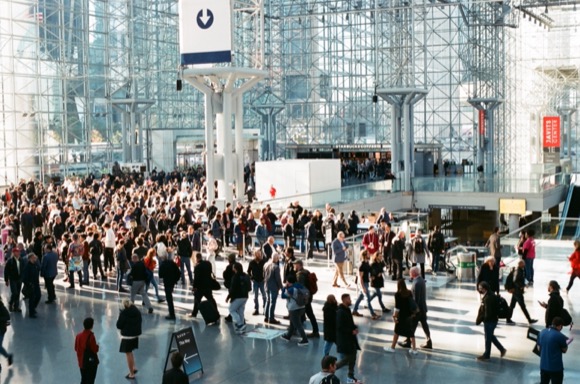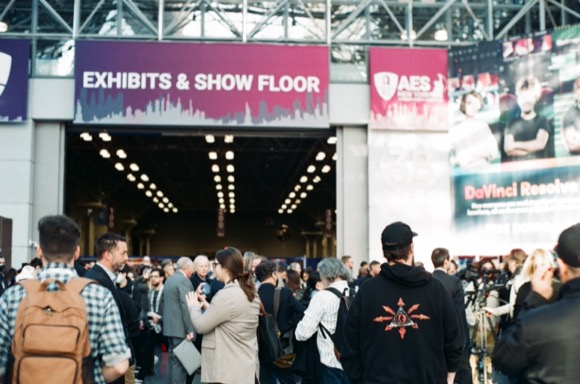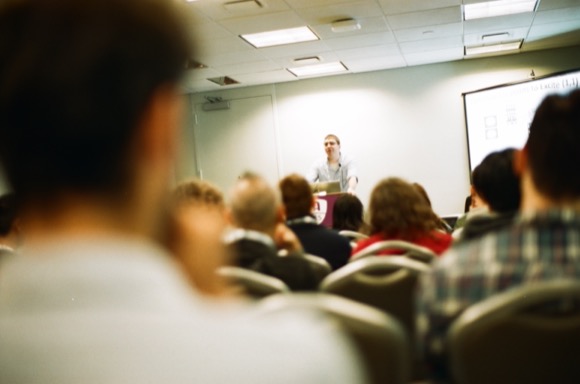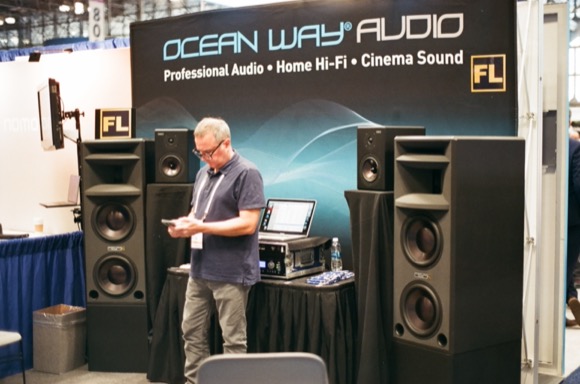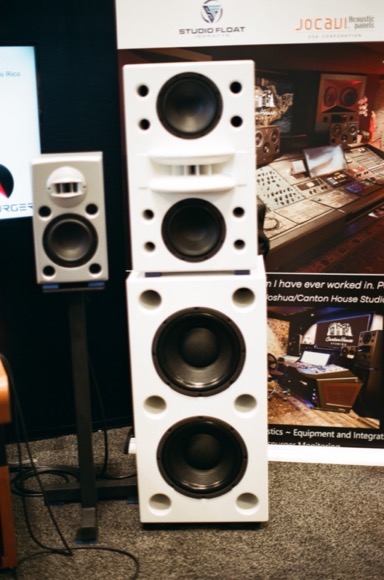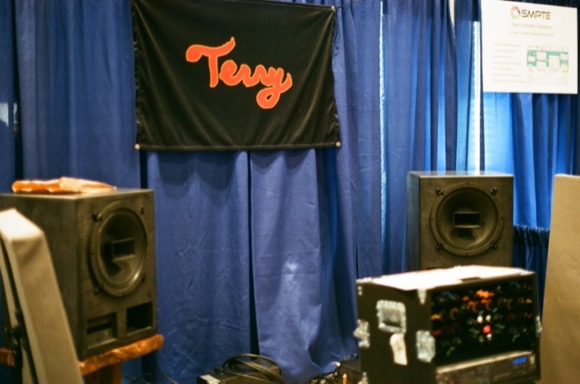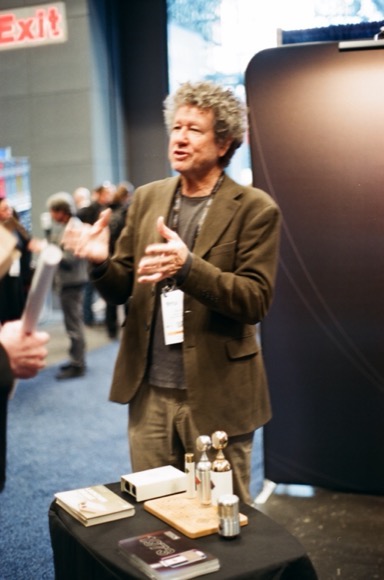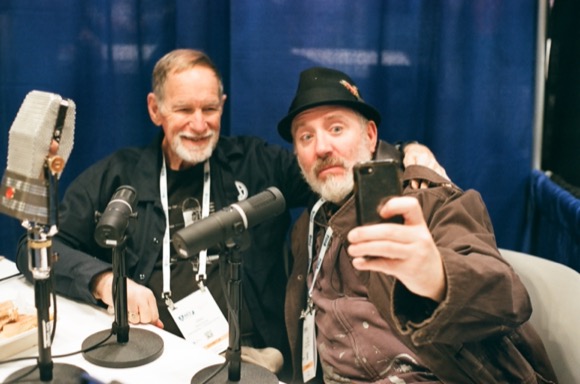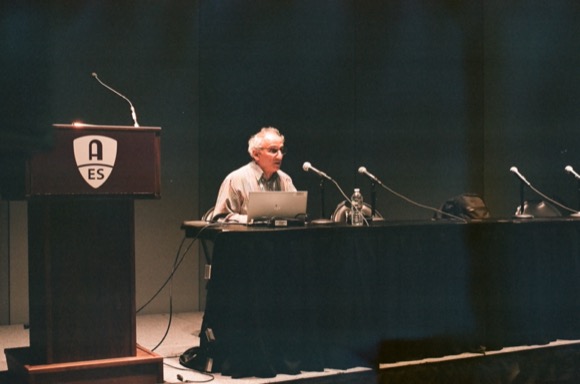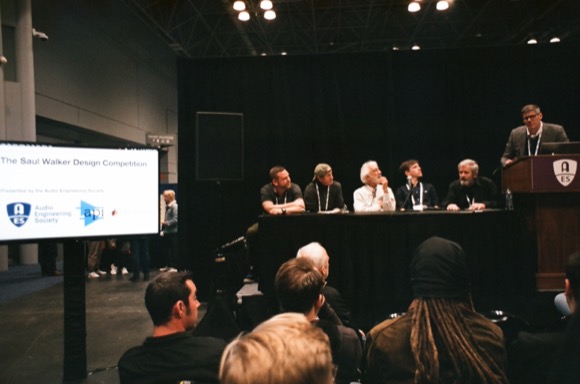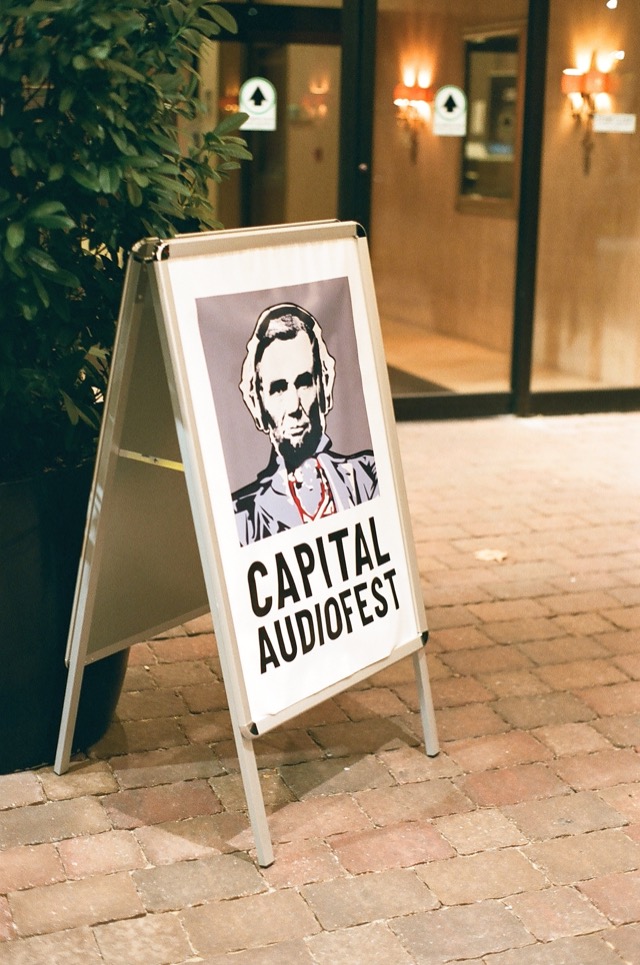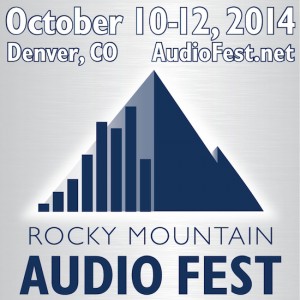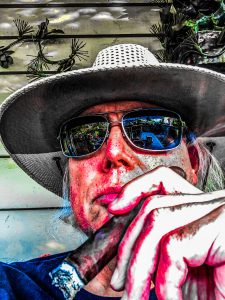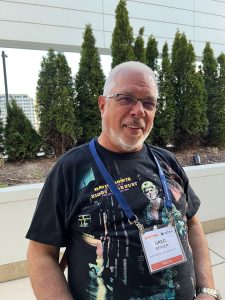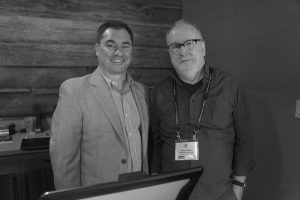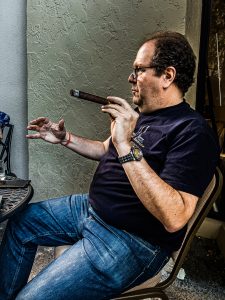People queuing up for registration
Trade Show Hall
This year's AES show was a bit unusual. The number of exhibitors was down to perhaps a quarter of what it normally is, and the number of papers was similarly reduced. This was made worse by a number of vendors and presenters who had been scheduled to be there not appearing. The show was reduced down to two days, with a third day that had a few tutorials.
Once again the AES partnered with the NAB in order to provide two events in the same convention center at the same time, and that is a great, great thing that I think promotes cross-fertilization.
Normally the AES has an exhibits only pass, which allows one to visit the exhibits floor, and an all-access pass which allows access to papers and all events. This year they added an "Exhibits Plus" ticket at a lower fee which allowed access to tutorials and workshops but not the paper sessions. I think this was probably a good idea but a lot of people with the yellow exhibits plus badges were being turned away at papers sessions because they apparently didn't realize what events they were allowed into and what they were not.
I think to make the Exhibits Plus thing actually work effectively there have to be more program items that you can attend with it.
It was, in fact, difficult to get badges at all with a half-hour line reaching across the lobby of the Javits, and a good bit of confusion on the part of some of the staff about handling the NAB passes versus the AES ones.
I feel really bad for Sue Williams who was spending so much time fixing stuff going wrong at the last minute. I missed one of the papers due to a badge problem (they initially issued me an NAB badge instead of an AES one because the press room wasn't set up to do AES badges) but if it hadn't have been for her timely help I might have missed them all.
The scheduling was even a worse disaster. The website never had a complete schedule on it; even a week after the convention it still has only a preliminary schedule. There were no paper schedules for papers and other events, and the website was apparently hard to use on a cellphone. All the big signs listing the schedules were taken down this year and there was only one computer monitor displaying the schedule that everyone was crowding around. It moved so quickly that you couldn't find anything easily unless you knew what room it was in already (and that's what most people wanted to know). When I got there a lot of the things I wanted to see had been moved and I had no real way of figuring out when and where they were moved. So even though there were only 54 papers total (a new low!) I wound up missing a number of them. Wish I could actually get copies of the prints but they aren't all there.
For example there was a paper on Wednesday called "Piezoelectric Actuators for Flat-Panel Loudspeakers" that was on the preliminary schedule on the website, but the E-library has no reference to that paper at all anywhere. Did it take place at all? I can't tell what happened.
I can't help but think that some of this chaos was caused by Colleen Harper stepping down as executive director in February, but really much of this stuff is quite inexcusable from anyone who has ever seen a trade show.
That said, there was an AES show and we should all be grateful there was anything at all after the last-minute cancellation of the Las Vegas show. It was small, and there were only 109 vendors on the trade show floor but it was there. And if I missed seeing a lot of people that I really needed to get in touch with, I did at least see some.
This year there was also a new category of papers marked "Convention Express Papers" to indicate that the abstracts had been peer-reviewed but not the papers themselves. I can't help but think this is a bad thing and is another indication of lack of planning but still it was better to include them than not.
Also I was amused to note that the exhibits floor smelled strongly of stale weed smoke throughout. It was very reminiscent of some of the studios where I first worked as a young intern.
Headphones
Audio-Technica was showing their M-40x and M-50x headphones and I am struck by the difference between the two which appear to be designed to meet very different target curves for different applications. I recommend listening to these but if you have heard one of them only I strongly recommend listening to them both on the same material to get a sense of the differences between them. Headphones are such a personal thing because your body is the listening room and so many different physical attributes of your body make for different sound. Even actual measured frequency response of a pair of headphones differs from one listener to another especially with closed-back phones.
A company called xMEMS Laboratories were introducing "microspeakers" using MEMS technology drivers where the entire driver is fabricated onto a single piece of silicon using the masking and etching techniques of the semiconductor industry. I couldn't tell much on the show floor but if you are interested in personal in-ear phones you should check them out.
Shure has upgraded their 440 and 840 headphones to new designs called the 440A and 840A. To be honest they appear to be completely new from the bottom up, from the drivers to the new frames. They are lighter and more comfortable on my ears than the headphones they replaced. THD at reference levels are reduced. Does that mean THD at the lower listening levels that I prefer are better? Do they sound as good? Do they sound better? Do they sound different? I can't tell on the show floor so you'll have to figure that part out by listening.
Audeze was also showing off a huge array of headphones including their newer MM-500 open-ear phones using planar magnetic drivers. These are not cheap but they are clearly designed for a professional studio environment.
Tom Miller Talks about Headphone Curves
There were a few papers on the headphone front, and the most interesting to me was "A Wideband Target Response Curve for Insert Earphones" by Tom Miller and Christina Downey. The first thing to say by word of background is that if you are listening to speakers in a perfect room with completely flat response, the response at your ears is not flat. This is because of your shoulders and your earlobes and because of that, headphones need to have response that isn't flat (but in an ideal world would be slightly different from person to person based on their body parameters). Some time ago, Sean Olive at Harmon tested people and came up with an average preferred response curve for headphones, which was what the average listener liked. It wasn't necessarily what was most accurate for that listener. Unfortunately, his measurements were really only accurate up to 10 KHz and there remained the question of what the top octave should look like. Miller and Downey did some testing to determine what the top octave should be and found that most people preferred a slight high frequency dropoff. This sort of research is very important because we have so many people listening on headphones and before we think about personal headphone responses we need to have a baseline. AES Convention Paper 10615.
Speakers
There is a whole family of different designs of studio monitors using wide dispersion wooden horns and initially using compression drivers from TAD in Japan. These designs have been used in a lot of control rooms over the years and although I am not personally a fan of horns for home or studio use, if you are a fan of horns you should definitely give some of these designs a listen.
Ocean Way Booth
Ocean Way Audio had a booth there showing off their HR3.5-FL, a three-way system with two horns and then two bass drivers that can be used standalone or with the change of a switch, soffit-mounted to give you more space in a small room like a control room.
Augspurger was showing their Solo 12MF monitors, which have a similar lineage and similar basic philosophy and pattern. Again worth checking out if you are in any way a horn fan.
And although Meyer Sound had a bunch of space devoted to the Panther line arrays for large venues, they also had a demo of the new Arnie studio monitors. This design is the grandchild of the old Meyer HD-1 and it is a very fine sounding small monitor for any uses.
Terry Audio Booth
Terry Audio was showing a pair of monitors that were based on Great Plains copies of the original Altec 604 drivers, basically emulating the classic Altec studio monitors of the sixties and seventies. These guys know the high end world too!
PSI from Switzerland was also showing off some excellent smaller monitor speakers but what I thought would be more interesting to the high end crowd was their AVAA C20 active bass trap. If you have a small room, you have acoustical issues on the low end, and adding full bass traps to reduce standing waves just makes the room that much smaller. The active bass trap is an effective broadband solution for low end control in small rooms. I wish they'd had a demo room for this because this is an easy thing to demonstrate in the typically awful hall acoustics of the show.
Microphones
Swedish Microphone Party
Independent Audio, which imports the Pearl and Milab microphones, did an off-site party and demo at the Power Station studio uptown. They had a great band set up, playing through a variety of Swedish microphones including the new VIP-60. These folks make some interesting square-diaphragm studio mikes but also some smaller microphones intended for sound reinforcement (but which are great in the studio too when you need to keep leakage down).
A couple years back Sony introduced the E-100 microphone, a two-way mike designed for wideband audio response way into the ultrasonic. I didn't like the etched top end on them, and I would have liked the microphone more without the second capsule for the extended high end. Apparently others felt the same way because Sony is now selling the E-80, which is the same basic design without the ultrasonic capsule or crossover, for around half the price. Definitely worth looking into if you are at all interested in studio microphones. I spent a good bit of time talking with Andy Munitz who is the product manager for those and who has great stories about the C-800G.
Soyuz Microphone Booth
Soyuz, an American company with Russian roots and manufacturing, has been making a few tube microphones for a while. They are now selling their model 1973, a FET-based condenser microphone designed by engineers trained at Oktava. In some ways this looks like a higher end design in the same basic pattern as the Oktava large diaphragm mikes.
A company called Harpex is now selling a microphone array using MEMS microphones. A flat baffle contains 84 individual microphones, 42 on a side, each of which are individually addressable by a host computer so beamforming can be done live or in postproduction. I don't know how practical this is in reality but the idea is ingenious and the implementation is excellent given the cost point.
A decade ago, AKG shut down a lot of their microphone and headphone operations in Europe, and Austrian Audio and Lewitt were founded by former AKG people to manufacture new products. Lewitt wasn't at the show this year but Austrian Audio was and showing a wide range of products including their OD303 dynamic vocal mike.
Wes Dooley and friend
AEA Microphones was showing off their various ribbon microphone designs including a microphone adapted from the original RCA BK-5 cardioid ribbon mike. Wes Dooley has recently retired from the company and was sitting in front of microphones instead of behind them, interviewing people about their ribbon mike experiences.
Down in the paper sessions, Jules Ryckebusch talked on an "Improved Microphone Converter using an Operational Amplifier." Unfortunately I only caught the last bit of this one and had to catch up with the written preprint. This is a rather novel design replacing the front end of a condenser microphone with a fet-based op-amp. I'm not sure about his test methodology and I'd like to see distortion and noise measurements made with a better model of the capsule but that might be the subject of the next paper. This was Convention Express Paper 12, and in a more normal convention would likely have been an engineering brief.
After this, Axel Germann and Joost Kriest talked about "Reducing Condenser Microphone Distortion Using a Single Chip Phantom Power Circuit." Joost Kriest has published several papers in the past detailing his "True Phantom" system which provides a better power source to deal with the nonlinearity of DC loads on the phantom power system, and now a company called Prema Semiconductor is manufacturing a single chip phantom powering solution that implements this. This is not really new research and is was more of a product announcement than not, but it was very interesting listening to some of the replies to audience questions about alternatives to this method. This really should have been an engineering brief but it was Convention Express Paper 13.
Cables
Canare had a booth but it was empty and no one showed up. Mogami did have a booth and they were showing off a whole lot of high flexibility cables with served shields for both balanced and unbalanced connections. I was checking out their 2893 star quad cable which is in-between a large microphone cable and a smaller lavalier mike cable.
Not quite what we think of as cable, but there was a company on the NAB side called FIS Blue which makes fibre optic cable assemblies for broadcasters. That includes tactical cables that you can drape across a fairground and lighter grade ruggedized cables that you can run from a mixing console to the digital stage box. They also made a few copper cable assemblies on a custom basis too, but as fibre becomes more popular in large installations these guys might be worth talking to.
Mixing
Jim Kaiser has been doing remote recording work and live broadcast mixes for many years in a recording truck or in makeshift spaces set up backstage at concerts. But with the coming of new teleconferencing technology in the Age of Covid he wondered if that could be done remotely from one's home. He built a fly-pack rack that could be shipped out to a concert, with a computer that ran a DAW, and with software that permitted that computer to be remotely controlled from his home. Stereo audio from the computer came back to his desktop, control signals from his console went back to the computer over the internet. Combine that with a PFL and intercom audio returns and it was just like being in the truck without having to put your pants on. He and Jody Elff have a company marketing this remote service under the name Harris-Elff Audio Resources and it was amazing just to see how effective the system was. You'd think control latency would be an issue but really it isn't. He did this in a workshop called "Remote Location Recording-- From Here to Anywhere."
A company called Softube was showing off some software but was also showing off some HUI gadgets that gave proper knob-and-fader controls for your gui application. If you're forced to mix in the box this could make it a lot easier.
Amandine Prasi has done work in the past on the techniques of self-taught production engineers in Mali, and more recently she has been doing some work in Ivory Coast. In "The Art of Remixing in Abdijan" she talked about some of the specific techniques used in digital production there. Convention Express Paper 20.
There was also a paper on a system for teaching students how to mix called "A Pedagogical System for Live Sound Reinforcement" by Brett Leonard and others from the University of Indianapolis. I wasn't able to see it because of the badge issues mentioned above but it's worth checking out their Convention Express Paper 30 for a description of their methods.
Signal Processing
Sennheiser announced that they were acquiring Merging Technologies, makers of the Pyramix DAW and a varieties of high-end interfaces designed for use with it. This means they'll be taking over marketing of the Merging products and we will miss Independent Audio who currently is distributing them in the US.
Panel On Parametric Equalization
George Massenburg, Duane Wise, and Udo Zoelzer all had a panel called "Fifty Years of Parametric EQ." This was a great discussion of how parametric equalization was first invented, then how it made its way from the analogue to the digital world, and then how folks did the math to make it work cleanly in the digital world. An enormous amount of history around one table for one hour.
There was a really interesting-looking paper scheduled called "Measuring Audibility Threshold Levels of Attack and Release in a Dynamic Range Compressor." This is interesting work not only because it tells us something useful for designing compressors but it also tells us something about audibility of transients. But, for some unknown reason the presenters from the UK did not show up in the room and the paper was cancelled, so this is another one of the things that I hope makes it to the European show in the spring.
Digital Audio
Prism Sound had a booth at the show but nobody showed up to man it, which was very disappointing.
Sonifex had a booth and they have a huge number of handy gadgets which go onto Dante digital audio networks and translate Dante data to other formats for general interface work.
Glensound was showing their model 165 which allows AES/EBU inputs and outputs to be routed to a Dante network, but they also had a whole variety of other cool Dante gadgets including things like flashing lights that can be triggered by Dante sources for cuing conductors and musicians.
More than a decade ago, Digital Audio Denmark was bought out by NTP Technology in Copenhagen, but they are still making hardware under the DAD name. This includes their Core 256 interface, which has an Apple Thunderbolt interface, a Dante interface, 128 channels of MADI, two 8-channel Lighpipe connectors and some limited DSP. Need to route Lightpipe to MADI? Need to record from Dante, MADI and lightpipe interfaces at the same time? You can do all of this which makes this device a handy gadget for live recordings where one might be working with sound reinforcement systems using different interfaces and configurations. This is a rosetta stone for allowing everything to talk.
Acoustical Supplies
Soundproof Windows was showing a variety of heavy and well constructed doors and windows for studios and listening rooms. If you're at all concerned about keeping sound leakage down you should investigate their products.
A company called Flex Acoustics was showing off variable absorption panels. I've seen these used extensively in large halls where there is a demand to use the same room for classical music that requires a live room and also for amplified music that needs a drier room. But Flex is showing systems also for smaller rooms like studios, home music rooms, and maybe even higher grade home listening rooms.
Down in the paper sessions, Malcolm Dunn and Grant Emms from New Zealand talked on "Room mode distribution criterion for non-rectangular rooms." They described the Walker Quality Index which is a measure of the spacing of low frequency modes in a room, and described it being used as to compare the rough quality of different room shapes. But they point out that as the room increases in size, the QI value naturally increases with the number of modes, and they suggest providing a correction factor for this and describe a method to do so. I am not so sure this is a good idea since in fact as rooms get larger they tend to perceptually get better and consequently the stock QI seems proportional to perceived room quality in that regard too. But read the paper and decide for yourself. Convention Express Paper 23.
Test Equipment
All the usual audio test vendors were absent this year aside from Klippel's excellent speaker test systems. Rhode and Schwartz had a booth over on the NAB side but they were just showing transmitters and none of their excellent test gear. SRI International was showing the "Sarnoff CSM" video test pattern suite with a lot of useful tests that show up problems with modern video systems. We have come a long way since that show with the Indian.
Standards
This year they continued the arrangement of the previous few years with the standards committees meeting online before the show itself. I like this a lot because it makes it much easier for people who may not be at the show to attend the meetings, and it makes it possible to have more frequent meetings which is a huge thing for some of the standards groups. I do rather wish there had been an informal get-together of the standards folks at the convention as well, however, just because there are some people I seldom see elsewhere.
Listening
If you've ever had a freshman psychology class you've heard of the Fletcher-Munson equal loudness contours. The work of Fletcher and Munson ninety years ago is still used today in discussing tonal changes with level. It turns out, though, that additional research has been done since then and not all of the measurements turn out to line up perfectly with that original work. In "State of the 'Equal Loudness Curves:' A Literature Review" Emily Porter and Patrick Kierman gave a survey of some of the data that has been done since. Convention Express Paper 19.
Menachem Rafelof
Menachem Rafelof from the National Institute of Aerospace was talking on "An Algorithm for Statistical Audibility Prediction of an Arbitrary Signal in the Presence of Noise." Simple weighted sound pressure level scales can describe perceived loudness of a sound but they don't do anything much to describe how audible it is. Dr. Rafelof describes an algorithm treating different bands of the spectrum differently in the same way the ear does, in order to give a good measurement of how audible a signal is in the presence of masking. The NIA cares about this because they want to know how audible aircraft will be, but you might care about whether your subwoofer will bother the people at the bowling alley and this is a model that will do just that. What is interesting here is that this wasn't a paper session. Dr. Rafelof along with Kyle Wendling published a paper in the JAES about this a year ago, and at the show a summary of that work and of work done since then was given in a product development workshop. How did this get to be a workshop? And why in the product development track? These questions may never be answered but many questions about audibility can be answered by looking up Dr. Rafelof's paper in the JAES.
Magazines
Recording and Musico Pro had a booth at the show and remarkably they seemed to be the only one of the audio magazines that did. Still, a lot of other magazines had people out at the show and the latest issues being given out.
The British magazine Audio/Media was there, and while they seem to have become more of a music magazine than an audio magazine in the decade or so of their absence, it was good to see them back.
AudioXPress had some people there but they weren't able to get promotional issues in time for the show.
Misc
One of the absolutely coolest things at the show was actually over on the NAB side where mycasebuilder.com was showing cases with custom foam that could be configured with an automated tool. They supply the tool, you show what size cutouts you want, then an automated machine cuts them out and you get a fully-configured custom case in the mail. No need to bring your equipment into a shop and have someone try to fit foam to it by hand. If you travel with any kind of delicate equipment from cameras to microphones this might make your life easier.
A company called Soundtoys appeared to be demonstrating some kind of software but they were using a small but high-powered subwoofer which could be heard all over the show floor. Even over in the NAB show rows you could hear the constant rhythmic thumping.
Saul Walker Design Competition Discussion
The AES Student Design contest received a grant from API and has been renamed the Saul Walker Design contest, and a panel of designers gave a great talk about why it's important, why teaching audio design to a new generation of engineers is critical to the future of the industry, and how they had learned their craft. This was a great panel with some great engineers and it made an incredibly important point. Thanks to API the contest now can actually give substantial cash prizes to students for winning designs and that is a marvelous thing. It was hard to hear the design contest panel even though the PA system was at outrageously high levels, because of the Mix with the Masters demo nearby which was at even more outrageously high levels. Both of these deserve to be in their own rooms and away from the show floor.
Louis Manno from the Audio History Library was there showing off a case of interesting vintage microphones. The Audio History Library has an archive of a lot of valuable equipment and documentation going way back but they don't have a place to display it. If you know of someone with a property available for a museum let them know!
Over on the NAB side, a company from Latvia called SAF Tehnika were showing studio-to-transmitter microwave links. What's amazing about the new digital video era is that everything is standardized so Europeans and Americans can sell to one another's market. The days of French TVs, British TVs, German TVs, and American TVs all being completely incompatible are long gone. Now, why audio people might be interested in these is that they provide tcp/ip bridging over microwave links. Just like you might want at a large festival ground or in a large concert using Dante for digital audio.
There were also a few papers I'd put in this category. People think of the AES show as a place to discuss audio production for music, but it's a lot more than that. This past May, a reporter named Shireen Abu Akleh was killed in Palestine and Israeli and Palestinian forces blamed one another. Robert Maher from Montana State has done a huge amount of research on sonic location of gunshots, and was asked to look into this. In "Interpretation of audio forensic information from the shooting of journalist Shireen Abu Akleh" he described his process. Two independent audio recordings were available but there was no common way to synchronize them to determine time of arrival differences. But what was available was the information that the shock wave of the bullet travels faster than the speed of sound in air, which is the rate that the initial muzzle sound travels. So knowing information about the cartridge itself (which was available) it's possible to determine the distance between the shooter and the recorder. This doesn't pin down the location of the shooter but it provides valuable information for more detailed investigation. Dr. Maher's discussion of the error bounds of his estimate is very interesting and helps explain the technique. This is the kind of thing that uses fundamental acoustics combined with some knowledge of a sound source to provide important information about an event and you will not see people talking about this kind of thing at NAMM. Convention Express Paper 22.
Tech Tours
There were three tech tours this year, but they were all on Friday after the conference was over. What's up with that? People had all left town by then, and none of the three really looked very interesting. Tech tours can be one of the best parts of the show but this year they weren't much. A friend who did attend the Ex Machina Soundworks tour did say it was a great tour, but maybe he was just happy to be in the exotic and distant borough of Brooklyn. Especially since the Dodgers had just beat the Padres.
Party Announcement
Conclusion
When I saw how small the vendor and paper lists were, I was hoping it would be like the post-911 show which was small and quiet but still had all the major vendors. It was small enough that you could actually spend time talking with people. Unfortunately what we got was quite the opposite, with very few papers and vendors and a huge number of people on the show floor. This is good for the exhibitors but probably bad for the AES which is presumably making more money from vendors than attendees on the whole.
But still, there was a show, and we all survived it, and even if a lot of stuff was missing and the schedule was incomprehensible, it was a lot better than no show at all.




